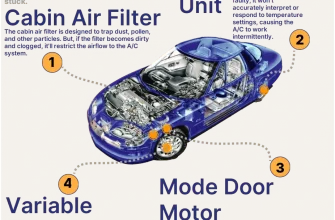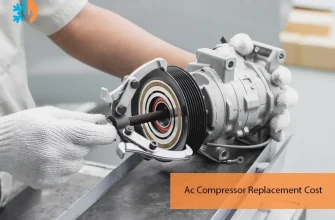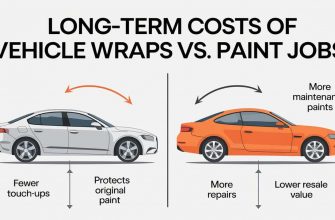In the intricate world of automotive electrical systems‚ relays play a crucial yet often overlooked role. These electrical devices serve as switches that control various components within a vehicle‚ enhancing safety‚ efficiency‚ and functionality. This article delves into the purpose‚ function‚ and importance of relays in modern automobiles.
- What is a Relay?
- The Functions of a Relay
- Types of Relays in Automotive Systems
- Common Applications of Relays in Vehicles
- The Importance of Relay Selection and Maintenance
- Future Innovations in Relay Technology
- The Future of Relays in Automotive Innovation
- Smart Relays: The Next Generation
- Challenges and Considerations
What is a Relay?
A relay is an electromechanical switch that uses an electromagnet to mechanically operate a switch. When an electrical current flows through the coil of the relay‚ it generates a magnetic field that pulls a lever‚ allowing the current to flow through the circuit. This simple yet effective mechanism enables relays to control high-power devices with low-power signals‚ making them indispensable in automotive applications.
The Functions of a Relay
Relays serve multiple functions in automotive electrical systems:
- Control High-Power Devices: Relays enable low-current switches to control high-current circuits‚ such as headlights‚ fuel pumps‚ and motors.
- Isolate Circuits: They provide electrical isolation between different parts of the system‚ protecting sensitive components from voltage spikes.
- Enhance Safety: By controlling the power supply to critical components‚ relays help prevent electrical overloads and potential fire hazards.
- Automate Functions: Many modern vehicles use relays in automated systems‚ such as power windows‚ central locking‚ and anti-theft systems.
Types of Relays in Automotive Systems
There are several types of relays commonly found in automotive applications:
- Electromechanical Relays: The most common type‚ these relays are activated by an electromagnetic coil.
- Solid State Relays: Utilizing semiconductor devices‚ these relays are faster and more durable than their electromechanical counterparts.
- Automotive Relays: Specifically designed for vehicle applications‚ these relays can handle the unique demands of automotive environments.
Common Applications of Relays in Vehicles
Relays are utilized in various applications throughout a vehicle:
- Lighting Systems: Headlights‚ brake lights‚ and turn signals often rely on relays for efficient operation.
- Fuel Pumps: Relays control the power supply to fuel pumps‚ ensuring they operate only when needed.
- Cooling Fans: Relays activate cooling fans based on temperature‚ optimizing engine performance.
- Starter Systems: The ignition relay is essential for starting the vehicle‚ connecting the battery to the starter motor.
The Importance of Relay Selection and Maintenance
While relays are often taken for granted‚ their performance can significantly impact a vehicle’s reliability and safety. Selecting the right relay for specific applications is critical. Factors such as current rating‚ voltage rating‚ and the type of load being controlled all play a role in ensuring optimal functionality. Automotive technicians and DIY enthusiasts should be aware of these specifications when replacing or upgrading relays in their vehicles.
Moreover‚ regular maintenance can extend the lifespan of relays. Corrosion‚ dirt‚ and moisture can impede the function of a relay‚ leading to failures in critical components. Periodic inspection of relay connections and ensuring that electrical contacts are clean can mitigate potential issues. Identifying and addressing signs of wear‚ such as unusual clicks or failure to engage‚ can prevent larger electrical problems down the road.
Future Innovations in Relay Technology
As automotive technology continues to evolve‚ so does the role of relays. The introduction of electric and hybrid vehicles has shifted the demand for relays that can handle higher voltages and currents. Solid-state relays‚ which offer faster switching times and greater durability‚ are becoming increasingly popular. These relays can withstand the rigors of modern automotive environments‚ including extreme temperatures and vibrations‚ making them ideal for advanced systems.
Additionally‚ the integration of smart technology into vehicles is paving the way for more sophisticated relay systems. Future vehicles may utilize integrated circuits that combine relays with microcontrollers‚ allowing for real-time monitoring and control of electrical systems. This innovation could lead to enhanced energy efficiency and improved performance‚ making vehicles smarter and more responsive to driver needs.
So next time you turn the key in your ignition or switch on your headlights‚ take a moment to acknowledge the small but mighty relay working diligently behind the scenes‚ contributing to the reliability and safety of your drive.
The Future of Relays in Automotive Innovation
As vehicle technology continues to advance‚ particularly with the rise of electric and autonomous vehicles‚ the role of relays is undergoing a transformation. The shift from traditional internal combustion engines to electric drivetrains necessitates relays that can handle higher voltages and currents while maintaining reliability and safety. This evolution has sparked interest in solid-state relays‚ which‚ unlike their electromechanical counterparts‚ have no moving parts. This fundamental difference not only enhances durability but also allows for faster switching speeds‚ making them ideal for high-performance applications.
Smart Relays: The Next Generation
In tandem with advancements in electric vehicles‚ the emergence of smart technology is redefining the capabilities of automotive relays. Smart relays integrate microcontrollers that can monitor and control electrical systems in real-time. Such innovation allows for adaptive responses to changing conditions‚ enhancing energy efficiency and overall vehicle performance. Imagine a relay that can diagnose a potential fault before it leads to a failure‚ alerting the driver through the vehicle’s infotainment system. This proactive approach to vehicle maintenance could revolutionize how we think about automotive care;
Challenges and Considerations
Despite the promising future of relays in automotive systems‚ several challenges remain. As vehicles become more electronically complex‚ the demand for reliable and efficient relays increases. Engineers must ensure that relays can withstand harsh automotive environments‚ including extreme temperatures‚ vibrations‚ and electromagnetic interference. Furthermore‚ the integration of multiple electrical systems in vehicles raises concerns about compatibility and performance‚ necessitating thorough testing and validation of relay designs.
Moreover‚ as manufacturers strive for sustainability‚ the materials used in relay construction are under scrutiny. The automotive industry is moving toward eco-friendly solutions‚ prompting the need for relays that are not only efficient but also sustainable. This includes using recyclable materials and minimizing waste during the production process‚ ensuring that innovative technology aligns with environmental responsibility.
Relays may be small components within the vast expanse of automotive electrical systems‚ but their significance cannot be overstated. As vehicles evolve with technological advancements‚ relays are poised to play a pivotal role in ensuring that these systems operate efficiently and safely. With ongoing innovations in relay technology‚ the future looks bright for this unsung hero of the automotive world. By embracing these advancements‚ manufacturers and consumers alike can look forward to a new era of vehicles that are not only smarter and more efficient but also safer and more reliable.
In the end‚ understanding the role of relays can empower drivers‚ technicians‚ and manufacturers to appreciate the intricate dance of technology that makes modern vehicles possible. As we look to the future‚ the relay stands as a testament to innovation‚ proving that sometimes the most significant breakthroughs come from the smallest components.









I found this article incredibly informative! The breakdown of relay functions really highlights their importance in modern vehicles.
Great insights into automotive relays! I appreciate how the article emphasizes both safety and automation aspects.
This article is a must-read for anyone interested in automotive technology. The clarity and depth of information on relays are impressive!
This article provides a fantastic overview of relays in automotive systems. I never realized how crucial they are for safety and efficiency!
A well-written piece that simplifies complex concepts about relays. It